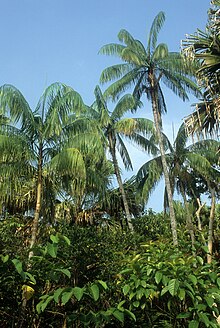Oncosperma tigillarium
| Oncosperma tigillarium | |
|---|---|
 |
|
| Oncosperma tigillarium in Malaysia | |
| Scientific classification | |
| Kingdom: | Plantae |
| (unranked): | Angiosperms |
| (unranked): | Monocots |
| (unranked): | Commelinids |
| Order: | Arecales |
| Family: | Arecaceae |
| Genus: | Oncosperma |
| Species: | O. tigilarium |
| Binomial name | |
|
Oncosperma tigillarium (Jack) Ridl. |
|
| Synonyms | |
|
|
Oncosperma tigilarium is a species of palm tree in the Arecaceae family.
Oncosperma tigilarium grows to 40 feet in height in dense thickets of up to 50 palm trees. The trunks of the palms are covered with long black spines. Oncosperma tigilarium has finely pinnate leaves, with drooping leaflets.
Its common name in Indonesion is nibung meaning thorn, for the long thorns that arise along the length of the trunk of the palm. In parts of the Philippines it is known as anibung in the Hiligaynon language.
The species is known from inland, lower salinity waters, near mangrove swamps of Indochina, Indonesia, Malaysia, and the Philippines in Southeast Asia. It is native to these areas west of the Wallace Line growing at elevations below 150 metres. It is endangered in some areas due to deforestation, and it is invasive to a few tropical islands in the Western Hemisphere where it has been planted as an ornamental.
In Singapore, A cluster of Nibong palms survive near the entrance of the Istana, located at the end of Orchard Road. A plaque at that site states: "As the nibong is a mangrove palm, this site must have once been a mangrove swamp."
...
Wikipedia
